
Een overzicht van de kernwoorden over het verkeer. Hier kunt u gemakkelijk kernwoorden en definities opzoeken die u nog niet kent.
More subjects
The aardvark (/ˈɑːrdvɑːrk/ ARD-vark; Orycteropus afer) is a medium-sized, burrowing, nocturnal mammal native to Africa. It is the only living species of the order Tubulidentata, although other prehistoric species and genera of Tubulidentata are known. Unlike most other insectivores, it has a long pig-like snout, which is used to sniff out food. It roams over most of the southern two-thirds of the African continent, avoiding areas that are mainly rocky. A nocturnal feeder, it subsists on ants and termites, which it will dig out of their hills using its sharp claws and powerful legs. It also digs to create burrows in which to live and rear its young. The animal is listed as 'least concern' by the IUCN, although its numbers are decreasing. Aardvarks are afrotheres, a clade which also includes elephants, manatees, and hyraxes. (Source: Wikipedia.org, CC BY-SA)
The aardwolf (Proteles cristata) is an insectivorous species of hyena, native to East and Southern Africa. Its name means 'earth-wolf' in Afrikaans and Dutch. It is also called maanhaar-jackal (Afrikaans for 'mane-jackal'), termite-eating hyena and civet hyena, based on its habit of secreting substances from its anal gland, a characteristic shared with the African civet. Unlike many of its relatives in the order Carnivora, the aardwolf does not hunt large animals. It eats insects and their larvae, mainly termites; one aardwolf can lap up as many as 250,000 termites during a single night using its long, sticky tongue. The aardwolf's tongue has adapted to be tough enough to withstand the strong bite of termites. (Source: Wikipedia.org, CC BY-SA)
The addax (Addax nasomaculatus), also known as the white antelope and the screwhorn antelope, is an antelope native to the Sahara Desert. The only member of the genus Addax, it was first described scientifically by Henri de Blainville in 1816. As suggested by its alternative name, the pale antelope has long, twisted horns – typically 55 to 80 cm (22 to 31 in) in females and 70 to 85 cm (28 to 33 in) in males. Males stand from 105 to 115 cm (41 to 45 in) at the shoulder, with females at 95 to 110 cm (37 to 43 in). They are sexually dimorphic, as the females are smaller than the males. The colour of the coat depends on the season – in the winter, it is greyish-brown with white hindquarters and legs, and long, brown hair on the head, neck, and shoulders; in the summer, the coat turns almost completely white or sandy blonde. (Source: Wikipedia.org, CC BY-SA)
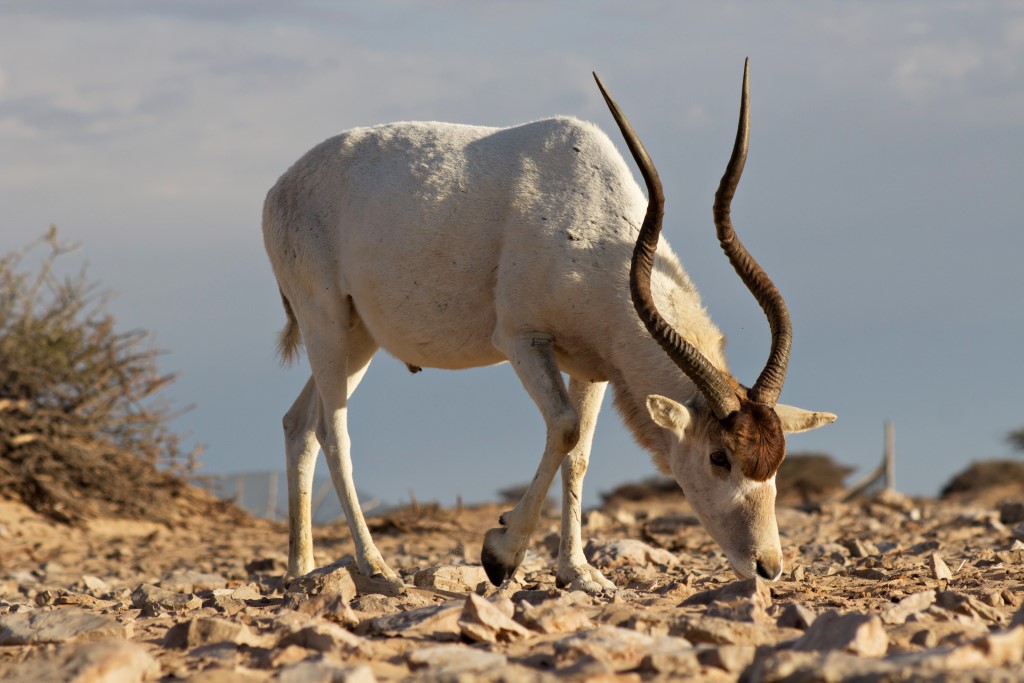 © Wikimedia.org/Haytem93, CC BY-SA
© Wikimedia.org/Haytem93, CC BY-SA
The African bush elephant (Loxodonta africana) is one of two extant African elephant species and one of three extant elephant species. It is the largest living terrestrial animal, with bulls reaching a shoulder height of up to 3.96 m (13 ft 0 in) and a body mass of up to 10.4 t (11.5 short tons). It is distributed across 37 African countries and inhabits forests, grasslands and woodlands, wetlands and agricultural land. Since 2021, it has been listed as Endangered on the IUCN Red List. It is threatened foremost by habitat destruction, and in parts of its range also by poaching for meat and ivory. It is a social mammal, travelling in herds composed of cows and their offspring. Adult bulls usually live alone or in small bachelor groups. It is a herbivore, feeding on grasses, creepers, herbs, leaves, and bark. The menstrual cycle lasts three to four months, and females are pregnant for 22 months, the longest gestation period of any mammal. (Source: Wikipedia.org, CC BY-SA)
The African civet (Civettictis civetta) is a large viverrid native to sub-Saharan Africa, where it is considered common and widely distributed in woodlands and secondary forests. It is listed as Least Concern on the IUCN Red List since 2008. In some countries, it is threatened by hunting, and wild-caught individuals are kept for producing civetone for the perfume industry. The African civet is primarily nocturnal and spends the day sleeping in dense vegetation, but wakes up at sunset. It is a solitary mammal with a unique coloration: the black and white blotches covering its coarse pelage and rings on the tail are an effective cryptic pattern. The black bands surrounding its eyes closely resemble those of the raccoon. Other distinguishing features are its disproportionately large hindquarters and its erectile dorsal crest. It is an omnivorous generalist, preying on small vertebrates, invertebrates, eggs, carrion, and vegetable matter. It is one of the few carnivores capable of eating toxic invertebrates such as termites and millipedes. It detects prey primarily by smell and sound rather than by sight. It is the sole member of the genus Civettictis. (Source: Wikipedia.org, CC BY-SA)
The African wild dog (Lycaon pictus), also called the painted dog or Cape hunting dog, is a wild canine which is a native species to sub-Saharan Africa. It is the largest wild canine in Africa, and the only extant member of the genus Lycaon, which is distinguished from Canis by dentition highly specialised for a hypercarnivorous diet, and by a lack of dewclaws. It is estimated that about 6,600 adults (including 1,400 mature individuals) live in 39 subpopulations that are all threatened by habitat fragmentation, human persecution, and outbreaks of disease. As the largest subpopulation probably comprises fewer than 250 individuals, the African wild dog has been listed as endangered on the IUCN Red List since 1990. The species is a specialised diurnal hunter of antelopes, which it catches by chasing them to exhaustion. Its natural enemies are lions and spotted hyenas: the former will kill the dogs where possible, whilst hyenas are frequent kleptoparasites. (Source: Wikipedia.org, CC BY-SA)
The alpaca (Lama pacos) is a species of South American camelid mammal. It is similar to, and often confused with, the llama. However, alpacas are often noticeably smaller than llamas. The two animals are closely related and can successfully crossbreed. Both species are believed to have been domesticated from their wild relatives, the vicuña and guanaco. There are two breeds of alpaca: the Suri alpaca and the Huacaya alpaca. Alpacas are kept in herds that graze on the level heights of the Andes of Southern Peru, Western Bolivia, Ecuador, and Northern Chile at an altitude of 3,500 to 5,000 metres (11,000 to 16,000 feet) above sea level. Alpacas are considerably smaller than llamas, and unlike llamas, they were not bred to be working animals, but were bred specifically for their fiber. Alpaca fiber is used for making knitted and woven items, similar to sheep's wool. These items include blankets, sweaters, hats, gloves, scarves, a wide variety of textiles, and ponchos, in South America, as well as sweaters, socks, coats, and bedding in other parts of the world. The fiber comes in more than 52 natural colors as classified in Peru, 12 as classified in Australia, and 16 as classified in the United States. (Source: Wikipedia.org, CC BY-SA)
 © Wikimedia.org/Philippe Lavoie, CC0
© Wikimedia.org/Philippe Lavoie, CC0
The Alpine goat is a medium to large sized breed of domestic goat known for its very good milking ability. They have no set colours or markings (although certain markings are discriminated against). They have horns, a straight profile and erect ears. The breed originated in the French Alps. Mature does weigh around 61 kg (135 lbs), and are about 76 cm (30 in) tall at the shoulder. Alpine goats can range from white or gray to brown and black. Alpine goats are heavy milkers. The milk can be made into butter, cheese, soap, ice cream or any other dairy product normally made from cow's milk. They are often used for commercial dairy production, as well as homestead milk goats. (Source: Wikipedia.org, CC BY-SA)
The Amazon river dolphin (Inia geoffrensis), also known as the boto, bufeo or pink river dolphin, is a species of toothed whale classified in the family Iniidae. Three subspecies are currently recognized: I. g. geoffrensis (Amazon river dolphin), I. g. boliviensis (Bolivian river dolphin) and I. g. humboldtiana (Orinoco river dolphin) while position of Araguaian river dolphin (I. araguaiaensis) within the clade is still unclear. The three subspecies are distributed in the Amazon basin, the upper Madeira River in Bolivia, and the Orinoco basin, respectively. The Amazon river dolphin is the largest species of river dolphin, with adult males reaching 185 kilograms (408 lb) in weight, and 2.5 metres (8.2 ft) in length. Adults acquire a pink color, more prominent in males, giving it its nickname 'pink river dolphin'. Sexual dimorphism is very evident, with males measuring 16% longer and weighing 55% more than females. Like other toothed whales, they have a melon, an organ that is used for bio sonar. The dorsal fin, although short in height, is regarded as long, and the pectoral fins are also large. The fin size, unfused vertebrae, and its relative size allow for improved manoeuvrability when navigating flooded forests and capturing prey. (Source: Wikipedia.org, CC BY-SA)
The American Pygmy is an American breed of achondroplastic goat. It is small, compact and stockily built. Like the Nigerian Dwarf, it derives from the West African Dwarf group of breeds of West Africa.: 355 : 35 Between 1930 and 1960, animals of this type were imported to the United States for use either as zoo animals or for research; some were later kept and bred as companion animals and established as a breed in 1975.: 355 : 40 It may also be known as the Pygmy or African Pygmy. It is quite different and separate from the British Pygmy breed. The American Pygmy is small and stocky, with heavy bone: height at the withers is usually in the range 40 to 50 cm (16 to 20 in), with weights of the order of 25 to 40 kg (55 to 88 lb).: 355 Seven color variations are recognised in the breed standard: caramel with black markings, caramel with brown markings, brown agouti, grey agouti, black agouti, black with white markings, and solid black. (Source: Wikipedia.org, CC BY-SA)
The Angora or Ankara is a Turkish breed of domesticated goat. It produces the lustrous fibre known as mohair. It is widespread in many countries of the world. Many breeds derive from it, among them the Indian Mohair, the Soviet Mohair, the Angora-Don of the Russian Federation and the Pygora in the United States. The Angora is a moderately small goat, standing about 50–55 cm at the withers.: 357 It is slender, elegant and light-framed; the head is small, with semi-lop ears. It is usually horned; in billies the horns are commonly twisted, long and strong.: 357 With the exception of the face and legs, the animal is entirely covered in a coat of long ringlets of fine and lustrous mohair. This is not goat hair as seen on other breeds, but the down or undercoat which, in this breed only, grows much longer than the outer hair coat. The face and coat are normally white, but – particularly in southern Turkey – black, brown, and grey animals also occur. (Source: Wikipedia.org, CC BY-SA)
Anteater is a common name for the four extant mammal species of the suborder Vermilingua (meaning 'worm tongue') commonly known for eating ants and termites. The individual species have other names in English and other languages. Together with the sloths, they are within the order Pilosa. The name 'anteater' is also commonly applied to the unrelated aardvark, numbat, echidnas, pangolins, and some members of the Oecobiidae, although they are not closely related to them. Extant species are the giant anteater Myrmecophaga tridactyla, about 1.8 m (5 ft 11 in) long including the tail; the silky anteater Cyclopes didactylus, about 35 cm (14 in) long; the southern tamandua or collared anteater Tamandua tetradactyla, about 1.2 m (3 ft 11 in) long; and the northern tamandua Tamandua mexicana of similar dimensions. (Source: Wikipedia.org, CC BY-SA)
The term antelope is used to refer to many species of even-toed ruminant that are indigenous to various regions in Africa and Eurasia. Antelope comprise a wastebasket taxon defined as any of numerous Old World grazing and browsing hoofed mammals belonging to the family Bovidae of the order Artiodactyla. A stricter definition, also known as the 'true antelopes,' includes only the genera Gazella, Nanger, Eudorcas and Antilope. One North American species, the pronghorn, is colloquially referred to as the 'American antelope,' but it belongs to a different family from the African and Eurasian antelopes. A group of antelope is called a herd. Unlike deer antlers, which are shed and grown annually, antelope horns grow continuously. (Source: Wikipedia.org, CC BY-SA)
Apes (collectively Hominoidea /hɒmɪˈnɔɪdi.ə/) are a clade of Old World simians native to sub-Saharan Africa and Southeast Asia (though they were more widespread in Africa, most of Asia, and as well as Europe in prehistory), which together with its sister group Cercopithecidae form the catarrhine clade, cladistically making them monkeys (though this is the subject of much debate). Apes do not have tails due to a mutation of the TBXT gene. In traditional and non-scientific use, the term 'ape' can include tailless primates taxonomically considered Cercopithecidae (such as the Barbary ape and black ape), and is thus not equivalent to the scientific taxon Hominoidea. There are two extant branches of the superfamily Hominoidea: the gibbons, or lesser apes; and the hominids, or great apes. (Source: Wikipedia.org, CC BY-SA)
The Arctic hare (Lepus arcticus) is a species of hare highly adapted to living in the Arctic tundra and other icy biomes. The Arctic hare survives with shortened ears and limbs, a small nose, fat that makes up close to 20% of its body, and a thick coat of fur. It usually digs holes in the ground or under the snow to keep warm and to sleep. Arctic hares look like rabbits but have shorter ears, are taller when standing, and, unlike rabbits, can thrive in extreme cold. They can travel together with many other hares, sometimes huddling with dozens or more, but are usually found alone, sometimes taking more than one partner. The Arctic hare can run up to 60 kilometres per hour (40 mph). (Source: Wikipedia.org, CC BY-SA)
The Arctic wolf (Canis lupus arctos), also known as the white wolf or polar wolf, is a subspecies of grey wolf native to the High Arctic tundra of Canada's Queen Elizabeth Islands, from Melville Island to Ellesmere Island. Unlike some populations that move between tundra and forest regions, Arctic wolves spend their entire lives north of the northern treeline. Their distribution to south is limited to the northern fringes of the Middle Arctic tundra on the southern half of Prince of Wales and Somerset Islands. It is a medium-sized subspecies, distinguished from the northwestern wolf by its smaller size, its whiter colouration, its narrower braincase, and larger carnassials. Since 1930, there has been a progressive reduction in size in Arctic wolf skulls, which is likely the result of wolf-dog hybridization. (Source: Wikipedia.org, CC BY-SA)
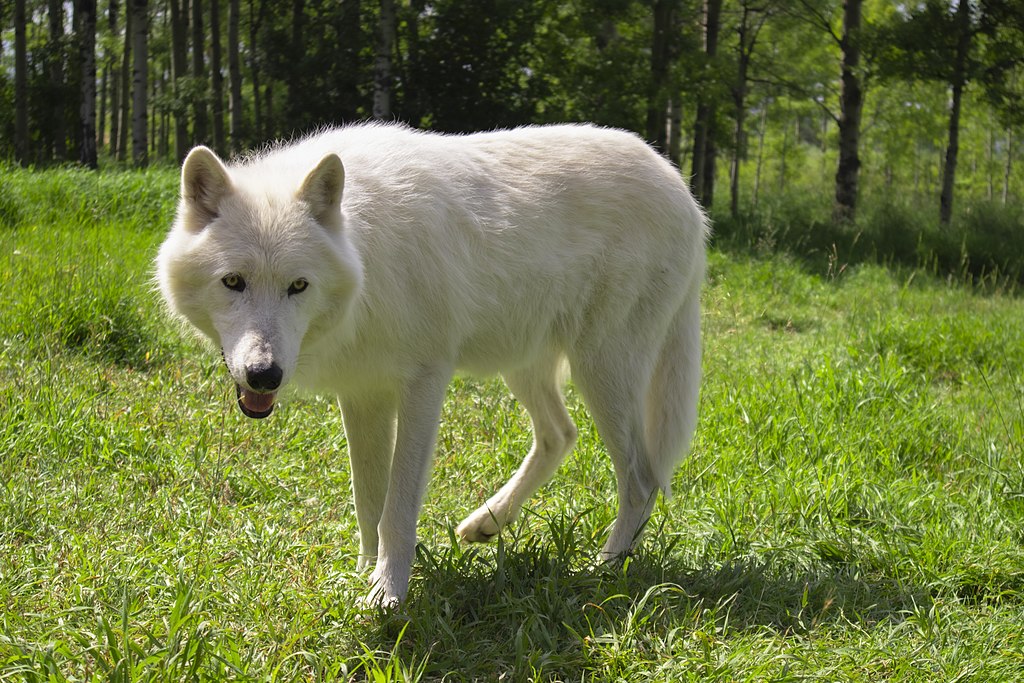 © Wikimedia.org/ParsonsPhotographyNL, CC BY-SA
© Wikimedia.org/ParsonsPhotographyNL, CC BY-SA
Armadillos (meaning 'little armored ones' in Spanish) are New World placental mammals in the order Cingulata. The Chlamyphoridae and Dasypodidae are the only surviving families in the order, which is part of the superorder Xenarthra, along with the anteaters and sloths. Nine extinct genera and 21 extant species of armadillo have been described, some of which are distinguished by the number of bands on their armor. All species are native to the Americas, where they inhabit a variety of different environments. Armadillos are characterized by a leathery armor shell and long, sharp claws for digging. They have short legs, but can move quite quickly. The average length of an armadillo is about 75 cm (30 in), including its tail. The giant armadillo grows up to 150 cm (59 in) and weighs up to 54 kg (119 lb), while the pink fairy armadillo has a length of only 13–15 cm (5–6 in). When threatened by a predator, Tolypeutes species frequently roll up into a ball; they are the only species of armadillo capable of this. (Source: Wikipedia.org, CC BY-SA)
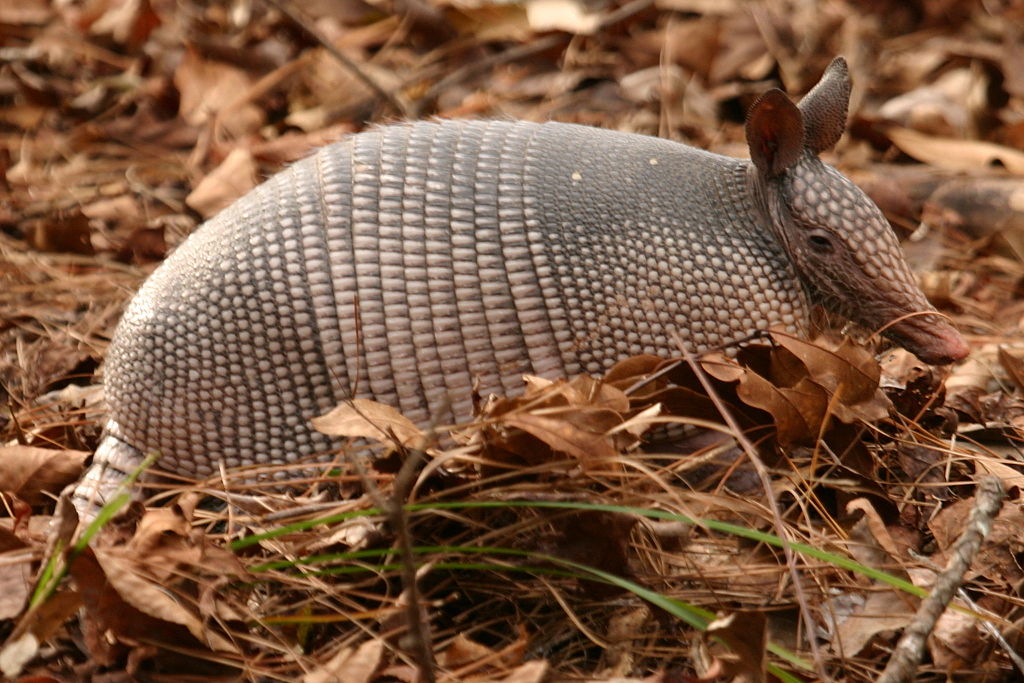 © Wikimedia.org/Mwcolgan8, CC0
© Wikimedia.org/Mwcolgan8, CC0
The Asian elephant (Elephas maximus), also known as the Asiatic elephant, is the only living species of the genus Elephas and is distributed throughout the Indian subcontinent and Southeast Asia, from India in the west, Nepal in the north, Sumatra in the south, and to Borneo in the east. Three subspecies are recognised—E. m. maximus from Sri Lanka, E. m. indicus from mainland Asia and E. m. sumatranus from the island of Sumatra. Formerly, there was also the Syrian elephant or Western Asiatic elephant (Elephas maximus asurus) which was the westernmost population of the Asian elephant (Elephas maximus). This subspecies became extinct in ancient times. Skeletal remains of E. m. asurus have been recorded from the Middle East: Iran, Iraq, Syria, and Turkey from periods dating between at least 1800 BC and likely 700 BC. It is one of only three living species of elephants or elephantids anywhere in the world, the others being the African bush elephant and African forest elephant. (Source: Wikipedia.org, CC BY-SA)
The Asian palm civet (Paradoxurus hermaphroditus), also called common palm civet, toddy cat and musang, is a viverrid native to South and Southeast Asia. Since 2008, it is IUCN Red Listed as Least Concern as it accommodates to a broad range of habitats. It is widely distributed with large populations that in 2008 were thought unlikely to be declining. In Indonesia, it is threatened by poaching and illegal wildlife trade; buyers use it for the increasing production of kopi luwak. The Asian palm civet's long, stocky body is covered with coarse, shaggy hair that is usually greyish in colour. It has a white mask across the forehead, a small white patch under each eye, a white spot on each side of the nostrils, and a narrow dark line between the eyes. The muzzle, ears, lower legs, and distal half of the tail are black, with three rows of black markings on the body. Its head-to-body length is about 53 cm (21 in) with a 48 cm (19 in) long unringed tail. It weighs 2 to 5 kg (4 to 11 lb). Its anal scent glands emit a nauseating secretion as a chemical defense when threatened or upset. (Source: Wikipedia.org, CC BY-SA)
The Asian black bear (Ursus thibetanus), also known as the Asiatic black bear, moon bear and white-chested bear, is a medium-sized bear species native to Asia that is largely adapted to an arboreal lifestyle. It lives in the Himalayas, southeastern Iran, the northern parts of the Indian subcontinent, the Korean Peninsula, China, the Russian Far East, the islands of Honshū and Shikoku in Japan, and Taiwan. It is listed as vulnerable on the IUCN Red List, and is threatened by deforestation and poaching for its body parts, which are used in traditional medicine. The Asian black bear has black fur, a light brown muzzle, and a distinct whitish or creamy patch on the chest, which is sometimes V-shaped. Its ears are bell shaped, proportionately longer than those of other bears, and stick out sideways from the head. Its tail is short, around 11 cm (4.3 in) long. Adults measure 70–100 cm (28–39 in) at the shoulder, and 120–190 cm (47–75 in) in length. Adult males weigh 60–200 kg (130–440 lb) with an average weight of about 135 kg (298 lb). Adult females weigh 40–125 kg (88–276 lb), and large ones up to 140 kg (310 lb). (Source: Wikipedia.org, CC BY-SA)
The aye-aye (Daubentonia madagascariensis) is a long-fingered lemur, a strepsirrhine primate native to Madagascar with rodent-like teeth that perpetually grow and a special thin middle finger. It is the world's largest nocturnal primate. It is characterized by its unusual method of finding food: it taps on trees to find grubs, then gnaws holes in the wood using its forward-slanting incisors to create a small hole into which it inserts its narrow middle finger to pull the grubs out. This foraging method is called percussive foraging, and takes up 5–41% of foraging time. The only other animal species known to find food in this way is the striped possum. From an ecological point of view, the aye-aye fills the niche of a woodpecker, as it is capable of penetrating wood to extract the invertebrates within. (Source: Wikipedia.org, CC BY-SA)
The Babirusas, whose name directly translates to Pig Deer in Malaysian Malay and English (Indonesian: babi rusa), are a genus, Babyrousa, in the swine family found in the Indonesian islands of Sulawesi, Togian, Sula and Buru. All members of this genus were considered part of a single species until 2002, the babirusa, B. babyrussa, but following that was split into several species. This scientific name is restricted to the Buru babirusa from Buru and Sula, whereas the best-known species, the north Sulawesi babirusa, is named B. celebensis. The remarkable 'prehistoric' appearance of these mammals is largely due to the prominent upwards incurving canine tusks of the males, which actually pierce the flesh in the snout. All species of babirusa are listed as threatened by the International Union for Conservation of Nature (IUCN). (Source: Wikipedia.org, CC BY-SA)
Baboons are primates comprising the genus Papio, one of the 23 genera of Old World monkeys. There are six species of baboon: the hamadryas baboon, the Guinea baboon, the olive baboon, the yellow baboon, the Kinda baboon and the chacma baboon. Each species is native to one of six areas of Africa and the hamadryas baboon is also native to part of the Arabian Peninsula. Baboons are among the largest non-hominoid primates and have existed for at least two million years. Baboons vary in size and weight depending on the species. The smallest, the Kinda baboon, is 50 cm (20 in) in length and weighs only 14 kg (31 lb), while the largest, the chacma baboon, is up to 120 cm (47 in) in length and weighs 40 kg (88 lb). All baboons have long, dog-like muzzles, heavy, powerful jaws with sharp canine teeth, close-set eyes, thick fur except on their muzzles, short tails, and nerveless, hairless pads of skin on their protruding buttocks called ischial callosities that provide for sitting comfort. Male hamadryas baboons have large white manes. Baboons exhibit sexual dimorphism in size, colour and/or canine teeth development. (Source: Wikipedia.org, CC BY-SA)
The Bactrian camel (Camelus bactrianus), also known as the Mongolian camel or domestic Bactrian camel, is a large even-toed ungulate native to the steppes of Central Asia. It has two humps on its back, in contrast to the single-humped dromedary. Its population of 2 million exists mainly in the domesticated form. Their name comes from the ancient historical region of Bactria. Domesticated Bactrian camels have served as pack animals in inner Asia since ancient times. With its tolerance for cold, drought, and high altitudes, it enabled the travel of caravans on the Silk Road. Bactrian camels, whether domesticated or feral, are a separate species from the wild Bactrian camel, which is the only truly wild (as opposed to feral) species of camelid in the Old World. (Source: Wikipedia.org, CC BY-SA)
Badgers are short-legged omnivores in the family Mustelidae (which also includes the otters, wolverines, martens, minks, polecats, weasels, and ferrets). Badgers are a polyphyletic rather than a natural taxonomic grouping, being united by their squat bodies and adaptions for fossorial activity. All belong to the caniform suborder of carnivoran mammals. The fifteen species of mustelid badgers are grouped in four subfamilies: four species of Melinae (genera Meles and Arctonyx) including the European badger, five species of Helictidinae (genus Melogale) or ferret-badger, the honey badger or ratel Mellivorinae (genus Mellivora), and the American badger Taxideinae (genus Taxidae). Badgers include the most basal mustelids; the American badger is the most basal of all, followed successively by the ratel and the Melinae; the estimated split dates are about 17.8, 15.5 and 14.8 million years ago, respectively. (Source: Wikipedia.org, CC BY-SA)
Baleen whales (systematic name Mysticeti), also known as whalebone whales, are a parvorder of carnivorous marine mammals of the infraorder Cetacea (whales, dolphins and porpoises) which use keratinaceous baleen plates (or 'whalebone') in their mouths to sieve planktonic creatures from the water. Mysticeti comprises the families Balaenidae (right and bowhead whales), Balaenopteridae (rorquals and the gray whale), and Cetotheriidae (the pygmy right whale). There are currently 16 species of baleen whales. While cetaceans were historically thought to have descended from mesonychids, molecular evidence instead supports them as a clade of even-toed ungulates (Artiodactyla). Baleen whales split from toothed whales (Odontoceti) around 34 million years ago. Baleen whales range in size from the 6 m (20 ft) and 3,000 kg (6,600 lb) pygmy right whale to the 31 m (102 ft) and 190 t (210 short tons) blue whale, the largest known animal to have ever existed. They are sexually dimorphic. Baleen whales can have streamlined or large bodies, depending on the feeding behavior, and two limbs that are modified into flippers. The fin whale is the fastest baleen whale, recorded swimming at 10 m/s (36 km/h; 22 mph). Baleen whales use their baleen plates to filter out food from the water by either lunge-feeding or skim-feeding. Baleen whales have fused neck vertebrae, and are unable to turn their heads at all. Baleen whales have two blowholes. Some species are well adapted for diving to great depths. They have a layer of fat, or blubber, under the skin to keep warm in the cold water. (Source: Wikipedia.org, CC BY-SA)
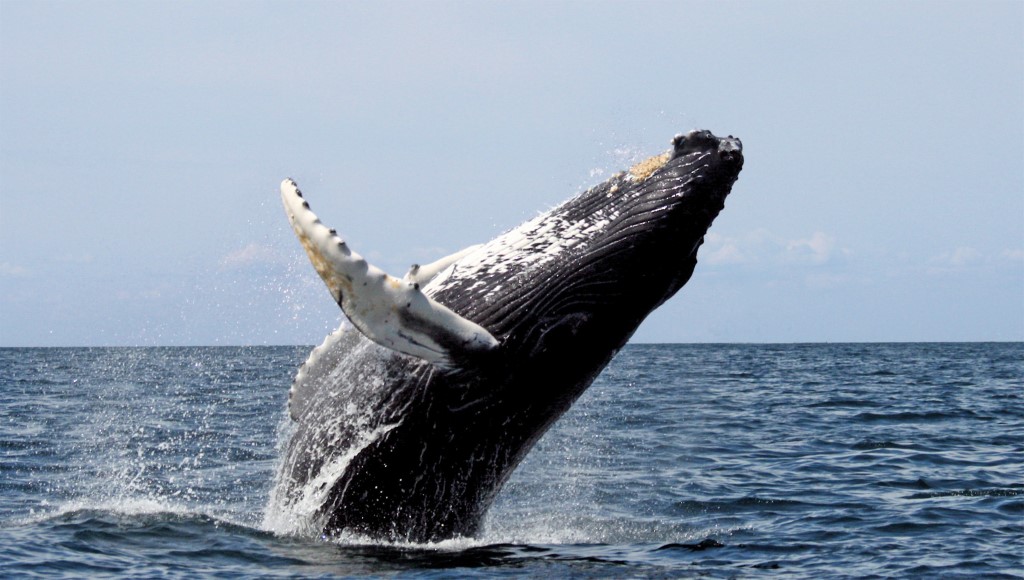 © Wikimedia.org/Whit Welles, CC BY
© Wikimedia.org/Whit Welles, CC BY
The banded palm civet (Hemigalus derbyanus), also called banded civet, is a viverrid native to Myanmar, Peninsular Malaysia, peninsular Thailand and the Sunda Islands of Sipura, Sumatra and Borneo. It is listed as Near Threatened on the IUCN Red List because of its large geographic and elevation range and tolerance to some habitat disturbance. The banded palm civet has a long pointed face, reminiscent of insectivorous mammals. It has a long body set on short legs, and five toes on each foot with retractable claws. It looks very similar to Owston's palm civet (Chrotogale owstoni), except that it lacks spots on its body, and the hair on its neck points upwards instead of down along the neck. It is also similar to the rare Hose's palm civet (Diplogale hosei), an endemic of northern Borneo - they only differ in shape of muzzle and teeth and Hose's civet does not have the banded pelage of the banded civet. The banded civet has short, dense fur that is generally a dark cream/buff color with four to five dark bands on its back. Its tail has two dark bands and the latter half of the tail is dark brown to black. There is a dark brown stripe that extends down the length of the top of the muzzle, and two stripes that extend from the top middle of the eye to the inside corner of the ears. There are two areas of white above and below each eye, and the muzzle is darker than the rest of the face. (Source: Wikipedia.org, CC BY-SA)
Bandicoots are a group of more than 20 species of small to medium-sized, terrestrial, largely nocturnal marsupial omnivores in the order Peramelemorphia. They are endemic to the Australia–New Guinea region, including the Bismarck Archipelago to the east and Seram and Halmahera to the west. Bandicoots have v-shaped faces, ending with their prominent noses similar to proboscises. These noses make them, along with bilbies, similar in appearance to elephant shrews and extinct leptictids, and they are distantly related to both mammal groups. With their well attuned snouts, and sharp claws, the bandicoot is a fossorial digger. They have small but fine teeth that allow them to easily chew their food. (Source: Wikipedia.org, CC BY-SA)
Bears are carnivoran mammals of the family Ursidae. They are classified as caniforms, or doglike carnivorans. Although only eight species of bears are extant, they are widespread, appearing in a wide variety of habitats throughout the Northern Hemisphere and partially in the Southern Hemisphere. Bears are found on the continents of North America, South America, Europe, and Asia. Common characteristics of modern bears include large bodies with stocky legs, long snouts, small rounded ears, shaggy hair, plantigrade paws with five nonretractile claws, and short tails. While the polar bear is mostly carnivorous, and the giant panda feeds almost entirely on bamboo, the remaining six species are omnivorous with varied diets. With the exception of courting individuals and mothers with their young, bears are typically solitary animals. They may be diurnal or nocturnal and have an excellent sense of smell. Despite their heavy build and awkward gait, they are adept runners, climbers, and swimmers. Bears use shelters, such as caves and logs, as their dens; most species occupy their dens during the winter for a long period of hibernation, up to 100 days. (Source: Wikipedia.org, CC BY-SA)
Beavers are large, semiaquatic rodents in the genus Castor native to the temperate Northern Hemisphere. There are two extant species: the North American beaver (Castor canadensis) and the Eurasian beaver (C. fiber). Beavers are the second-largest living rodents after the capybaras. They have stout bodies with large heads, long chisel-like incisors, brown or gray fur, hand-like front feet, webbed back feet and flat, scaly tails. The two species differ in the shape of the skull and tail and fur color. Beavers can be found in a number of freshwater habitats, such as rivers, streams, lakes and ponds. They are herbivorous, consuming tree bark, aquatic plants, grasses and sedges. Beavers build dams and lodges using tree branches, vegetation, rocks and mud; they chew down trees for building material. Dams impound water and lodges serve as shelters. Their infrastructure creates wetlands used by many other species, and because of their effect on other organisms in the ecosystem, they are considered a keystone species. Adult males and females live in monogamous pairs with their offspring. When they are old enough, the young will help their parents repair dams and lodges and may also help raise newly born offspring. Beavers hold territories and mark them using scent mounds made of mud, debris and castoreum, a liquid substance excreted through the beaver's castor sacs. Beavers can also recognize their kin by their anal gland secretions and are more likely to tolerate them as neighbors. (Source: Wikipedia.org, CC BY-SA)
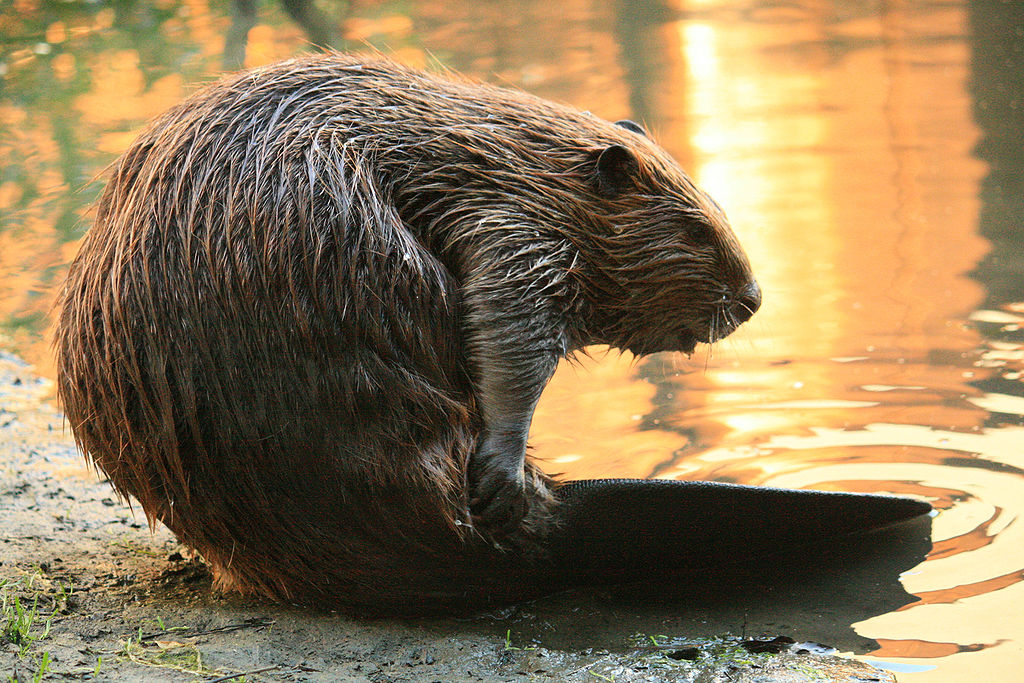 © Wikimedia.org/Cheryl Reynolds, CC BY-SA
© Wikimedia.org/Cheryl Reynolds, CC BY-SA
Beefalo constitute a hybrid offspring of domestic cattle (Bos taurus), usually a male in managed breeding programs, and the American bison (Bison bison), usually a female in managed breeding programs. The breed was created to combine the characteristics of both animals for beef production. Beefalo are primarily cattle in genetics and appearance, with the breed association defining a full Beefalo as one with three-eighths (37.5%) bison genetics, while animals with higher percentages of bison genetics are called 'bison hybrids'. (Source: Wikipedia.org, CC BY-SA)
The Bengal tiger is a population of the Panthera tigris tigris subspecies. It ranks among the biggest wild cats alive today. It is considered to belong to the world's charismatic megafauna. The tiger is estimated to have been present in the Indian subcontinent since the Late Pleistocene, for about 12,000 to 16,500 years. Today, it is threatened by poaching, loss and fragmentation of habitat, and was estimated at comprising fewer than 2,500 wild individuals by 2011. None of the Tiger Conservation Landscapes within its range is considered large enough to support an effective population of more than 250 adult individuals. The Bengal tiger's coat is yellow to light orange, with stripes ranging from dark brown to black; the belly and the interior parts of the limbs are white, and the tail is orange with black rings. The white tiger is a recessive mutant, which is reported in the wild from time to time in Assam, Bengal, Bihar, and especially in the former State of Rewa. However, it is not an occurrence of albinism. In fact, there is only one fully authenticated case of a true albino tiger, and none of black tigers, with the possible exception of one dead specimen examined in Chittagong in 1846. Fourteen Bengal tiger skins in the collection of the Natural History Museum, London have 21–29 stripes. (Source: Wikipedia.org, CC BY-SA)
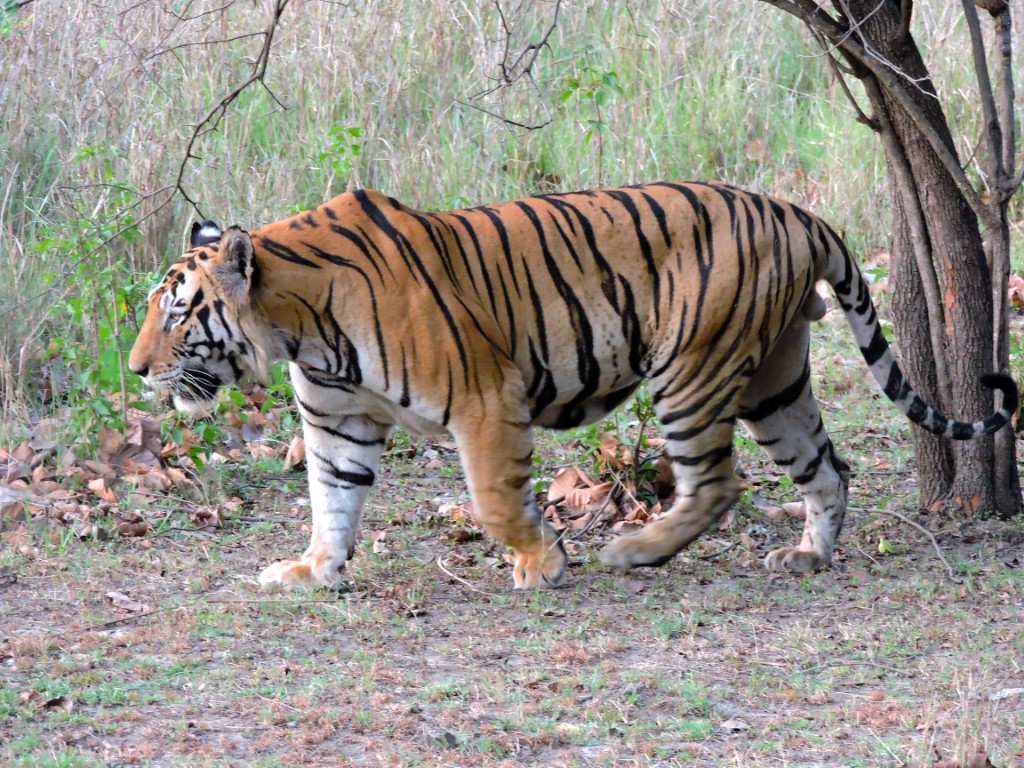 © Wikimedia.org/Seemaleena, CC BY-SA
© Wikimedia.org/Seemaleena, CC BY-SA
The bighorn sheep (Ovis canadensis) is a species of sheep native to North America. It is named for its large horns. A pair of horns might weigh up to 14 kg (30 lb); the sheep typically weigh up to 143 kg (315 lb). Recent genetic testing indicates three distinct subspecies of Ovis canadensis, one of which is endangered: O. c. sierrae. Bighorn sheep are named for the large, curved horns borne by the rams (males). Ewes (females) also have horns, but they are shorter with less curvature. They range in color from light brown to grayish or dark, chocolate brown, with a white rump and lining on the backs of all four legs. Males typically weigh 58–143 kg (128–315 lb), are 90–105 cm (35–41 in) tall at the shoulder, and 1.6–1.85 m (63–73 in) long from the nose to the tail. Females are typically 34–91 kg (75–201 lb), 75–90 cm (30–35 in) tall, and 1.28–1.58 m (50–62 in) long. Male bighorn sheep have large horn cores, enlarged cornual and frontal sinuses, and internal bony septa. These adaptations serve to protect the brain by absorbing the impact of clashes. Bighorn sheep have preorbital glands on the anterior corner of each eye, inguinal glands in the groin, and pedal glands on each foot. Secretions from these glands may support dominance behaviors. (Source: Wikipedia.org, CC BY-SA)
 © Wikimedia.org/Jwanamaker, CC BY-SA
© Wikimedia.org/Jwanamaker, CC BY-SA
Macrotis is a genus of desert-dwelling marsupial omnivores known as bilbies or rabbit-bandicoots; they are members of the order Peramelemorphia. At the time of European colonisation of Australia, there were two species. The lesser bilby became extinct in the 1950s; the greater bilby survives but remains endangered. It is currently listed as a vulnerable species. The greater bilby is on average 55 cm (22 in) long, excluding the tail, which is usually around 29 cm (11 in) long. Its fur is usually grey or white; it has a long, pointy nose and very long ears, hence the reference of its nickname to rabbits. Bilbies have the characteristic long bandicoot muzzle and very big ears that radiate heat. They are about 29–55 cm (11–22 in) long. Compared to bandicoots, they have a longer tail, bigger ears, and softer, silky fur. The size of their ears allows them to have better hearing. They are nocturnal omnivores that do not need to drink water, as they obtain their moisture from food, which includes insects and their larvae, seeds, spiders, bulbs, fruit, fungi, and very small animals. Most food is found by digging or scratching in the soil, and using their very long tongues. (Source: Wikipedia.org, CC BY-SA)
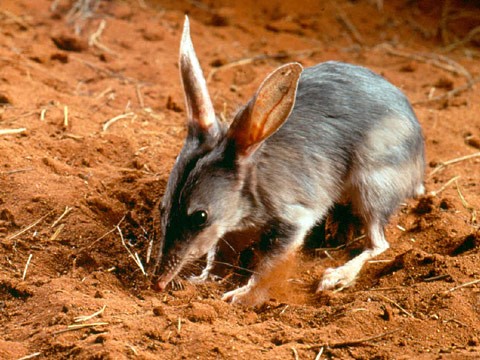 © Wikimedia.org/Kevin503, CC BY-SA
© Wikimedia.org/Kevin503, CC BY-SA
The binturong (Arctictis binturong) (/bɪnˈtjʊərɒŋ, ˈbɪntjʊrɒŋ/, bin-TURE-ong, BIN-ture-ong), also known as the bearcat, is a viverrid native to South and Southeast Asia. It is uncommon in much of its range, and has been assessed as Vulnerable on the IUCN Red List because of a declining population trend that is estimated at more than 30% since the mid-1980s. The binturong is the only living species in the genus Arctictis. The binturong is long and heavy, with short, stout legs. It has a thick coat of coarse black hair. The bushy and prehensile tail is thick at the root, gradually tapering, and curls inwards at the tip. The muzzle is short and pointed, somewhat turned up at the nose, and is covered with bristly hairs, brown at the points, which lengthen as they diverge, and form a peculiar radiated circle round the face. The eyes are large, black and prominent. The ears are short, rounded, edged with white, and terminated by tufts of black hair. There are six short rounded incisors in each jaw, two canines, which are long and sharp, and six molars on each side. The hair on the legs is short and of a yellowish tinge. The feet are five-toed, with large strong claws; the soles are bare, and are plantigrade: applied to the ground throughout the whole of their length; the hind ones are longer than the fore ones. (Source: Wikipedia.org, CC BY-SA)
Bison are large bovines in the genus Bison (Greek: 'wild ox' (bison)) within the tribe Bovini. Two extant and numerous extinct species are recognised. The American bison and the European bison (wisent) are the largest surviving terrestrial animals in North America and Europe. They are typical artiodactyl (cloven hooved) ungulates, and are similar in appearance to other bovines such as cattle and true buffalo. They are broad and muscular with shaggy coats of long hair. Adults grow up to 2 metres (6 feet 7 inches) in height and 3.5 m (11 ft 6 in) in length for American bison and up to 2.1 m (6 ft 11 in) in height and 2.9 m (9 ft 6 in) in length for European bison. American bison can weigh from around 400 to 1,270 kilograms (880 to 2,800 pounds) and European bison can weigh from 800 to 1,000 kg (1,800 to 2,200 lb). European bison tend to be taller than American bison. (Source: Wikipedia.org, CC BY-SA)
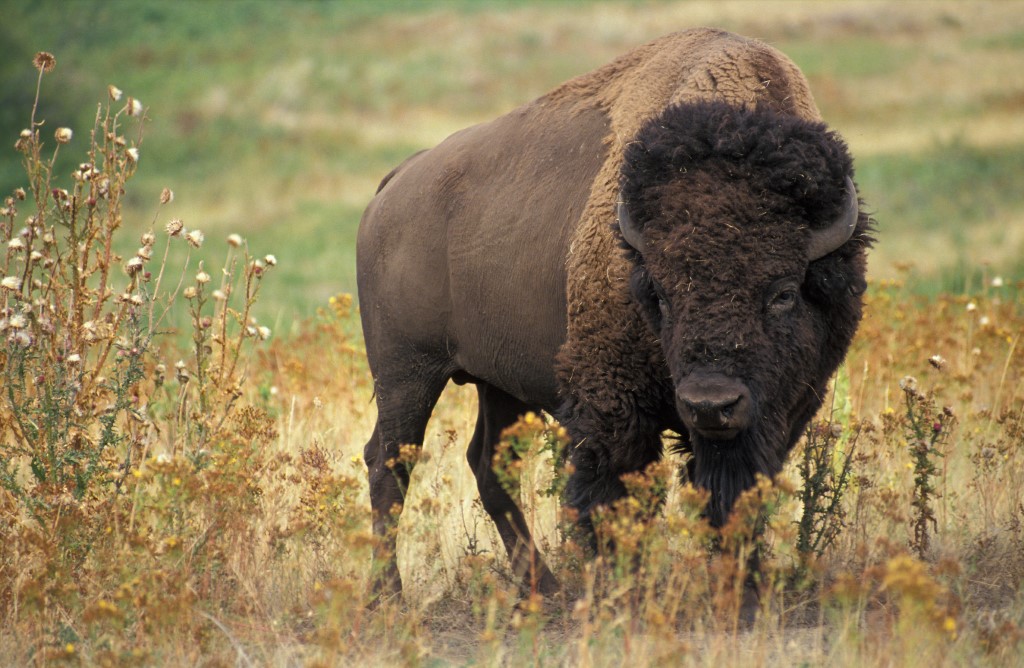 © Wikimedia.org/Jack Dykinga, CC0
© Wikimedia.org/Jack Dykinga, CC0
The black rhinoceros, black rhino or hook-lipped rhinoceros (Diceros bicornis) is a species of rhinoceros, native to eastern and southern Africa including Angola, Botswana, Kenya, Malawi, Mozambique, Namibia, South Africa, Eswatini, Tanzania, Zambia, and Zimbabwe. Although the rhinoceros is referred to as black, its colours vary from brown to grey. An adult black rhinoceros stands 140–180 cm (55–71 in) high at the shoulder and is 3–3.75 m (9.8–12.3 ft) in length. An adult typically weighs from 800 to 1,400 kg (1,760 to 3,090 lb), however unusually large male specimens have been reported at up to 2,896 kg (6,385 lb). The cows are smaller than the bulls. Two horns on the skull are made of keratin with the larger front horn typically 50 cm (20 in) long, exceptionally up to 140 cm (55 in). (Source: Wikipedia.org, CC BY-SA)
The black black-footed ferret (Mustela nigripes), also known as the American polecat or prairie dog hunter, is a species of mustelid native to central North America. The black-footed ferret is roughly the size of a mink and is similar in appearance to the European polecat and the Asian steppe polecat. It is largely nocturnal and solitary, except when breeding or raising litters. Up to 90% of its diet is composed of prairie dogs. The black-footed ferret has a long, slender body with black outlines on its paws, ears, parts of its face and its tail. The forehead is arched and broad, and the muzzle is short. It has few whiskers, and its ears are triangular, short, erect and broad at the base. The neck is long and the legs short and stout. The toes are armed with sharp, very slightly arched claws. The feet on both surfaces are covered in hair, even to the soles, thus concealing the claws. It combines several physical features common in both members of the subgenus Gale (least and short-tailed weasels) and Putorius (European and steppe polecats). Its skull resembles that of polecats in its size, massiveness and the development of its ridges and depressions, though it is distinguished by the extreme degree of constriction behind the orbits where the width of the cranium is much less than that of the muzzle. (Source: Wikipedia.org, CC BY-SA)
The blue whale (Balaenoptera musculus) is a marine mammal and a baleen whale. Reaching a maximum confirmed length of 29.9 meters (98 ft) and weighing up to 199 tonnes (196 long tons; 219 short tons), it is the largest animal known to have ever existed. The blue whale's long and slender body can be of various shades of greyish-blue dorsally and somewhat lighter underneath. Four subspecies are recognized: B. m. musculus in the North Atlantic and North Pacific, B. m. intermedia in the Southern Ocean, B. m. brevicauda (the pygmy blue whale) in the Indian Ocean and South Pacific Ocean, B. m. indica in the Northern Indian Ocean. There is also a population in the waters off Chile that may constitute a fifth subspecies. In general, blue whale populations migrate between their summer feeding areas near the poles and their winter breeding grounds near the tropics. There is also evidence of year-round residencies, and partial or age/sex-based migration. Blue whales are filter feeders; their diet consists almost exclusively of krill. They are generally solitary or gather in small groups, and have no well-defined social structure other than mother-calf bonds. The fundamental frequency for blue whale vocalizations ranges from 8 to 25 Hz and the production of vocalizations may vary by region, season, behavior, and time of day. Orcas are their only natural predators. (Source: Wikipedia.org, CC BY-SA)
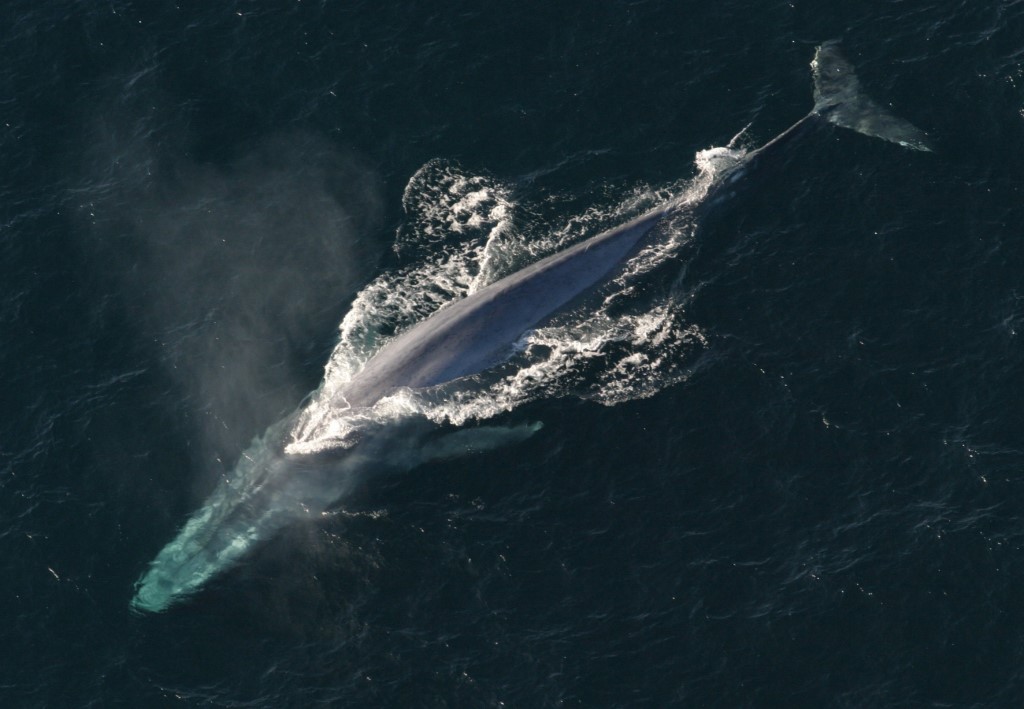 © Wikimedia.org/NOAA, CC0
© Wikimedia.org/NOAA, CC0
The bongo (Tragelaphus eurycerus) is a herbivorous, mostly nocturnal forest ungulate. Bongos are characterised by a striking reddish-brown coat, black and white markings, white-yellow stripes and long slightly spiralled horns. They are the only tragelaphid in which both sexes have horns. They have a complex social interaction and are found in African dense forest mosaics. Native to Africa, they are the third-largest antelope in the world. Bongos are one of the largest of the forest antelopes. In addition to the deep chestnut colour of their coats, they have bright white stripes on their sides to help with camouflage. Adults of both sexes are similar in size. Adult height is about 1.1 to 1.3 m (3.6 to 4.3 ft) at the shoulder and length is 2.15 to 3.15 m (7.1 to 10.3 ft), including a tail of 45–65 cm (18–26 in). Females weigh around 150–235 kg (331–518 lb), while males weigh about 220–405 kg (485–893 lb). Its large size puts it as the third-largest in the Bovidae tribe of Strepsicerotini, behind both the common and greater elands by about 300 kg (660 lb), and above the greater kudu by about 40 kg (88 lb). (Source: Wikipedia.org, CC BY-SA)

Time for recess! Post a comment, ask a question or write a review. Feel free to let us know what you think!
Vwb borden verkeersplein en rotonde slaat U hier de plank behoorlijk mis. Mag wel eens aangepast worden. Jammer.
ABS Nedir Nasıl Çalışır ? - https://www.diskfren.com/abs-nedir-nasil-calisir.html
Driving whit a tractor possible? What are the requirements? Can i drive whit a dutch T-licence?
Tot waar geldt een verkeersbord? In België is dat tot het volgende kruispunt, in Spanje lijkt het verder te reiken.
Waar kan ik het bord vinden, einde werk in uitvoering. Er staat dan een schuine streep er door.
Waar kan ik hetbord vinden, einde werk in uitvoering. Er staat dan een schuine streep er door.
بعضی سوالها طوری ترراهی شده ذهن مراجعین رامختل می کند.تااینکه معلومات را اضافه کند
Bij ons staat in het park een bord rond met een poepende hond erop is dat een verbodsbord of een opmerkings bord ? Ze laten de honden poepen en lopen gewoon lekker door kan dat zo maar ???
ik wil met kleine aanhanger zonder eigen kenteken naar de oekraine kan dat ,zonder probleem
Instructies onduidelijk, ben met verkeersbord tegen auto aangereden (geintje). Ik had wel wat aan de random test, truckje dat mij enorm hielp is een patroon ontdekken in de vorm en kleur van bord en en aangegeven symbool, dan kun je het juiste antwoord meestal wel raden,ook als je niet zeker bent.
Oei ! Ik dacht hier de Thaise wegcode te vinden in het NL ? Blijkbaar mis ? Iemand een LINK waar ik dat wel kan vinden, Thaise wegcode met verkeersborden en info in het Nederlands? Mag altijd gestuurd worden ...
Beste student! Op deze pagina proberen we u iets bij te leren over de verkeersregels. Laat ons weten wat u ervan vindt!